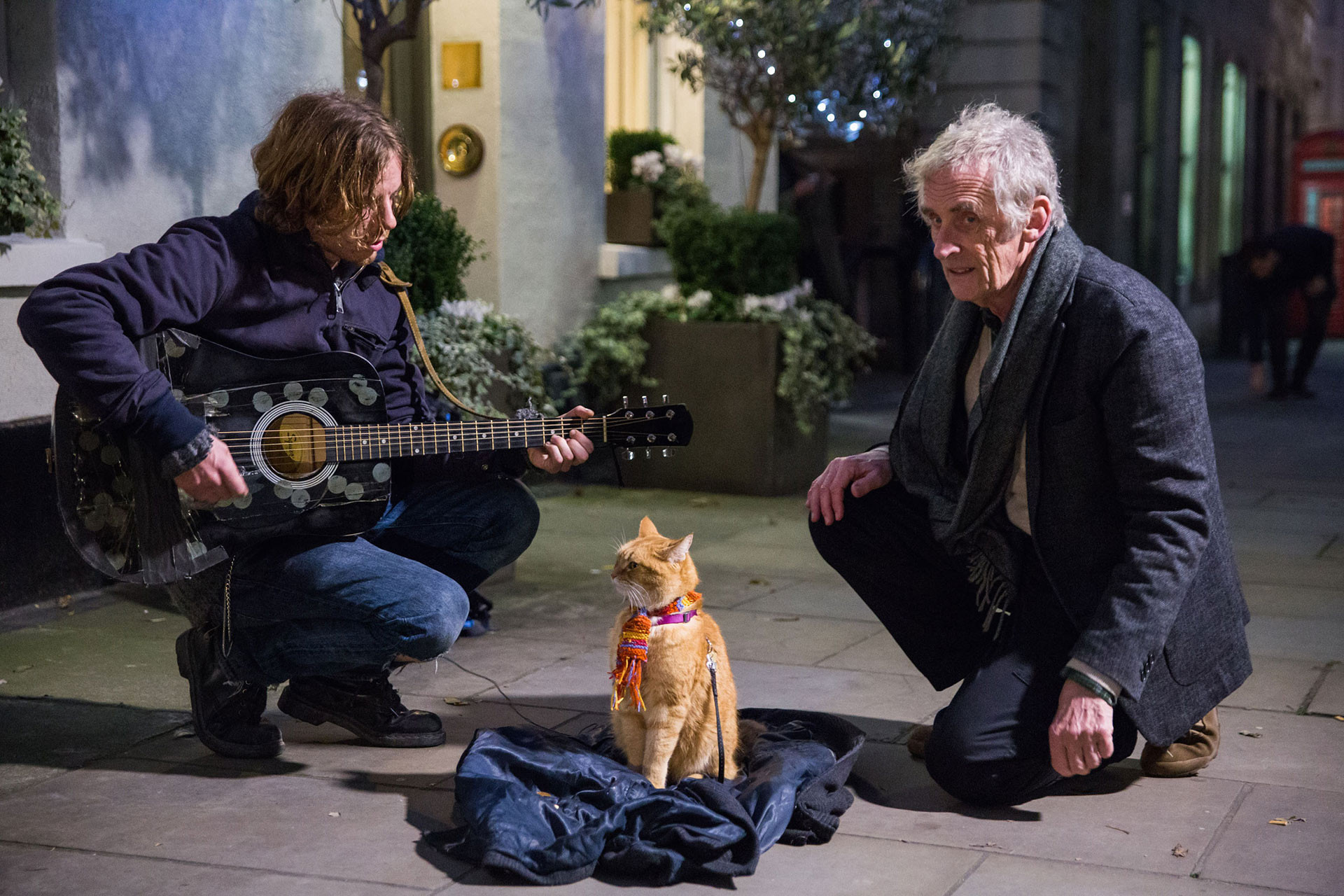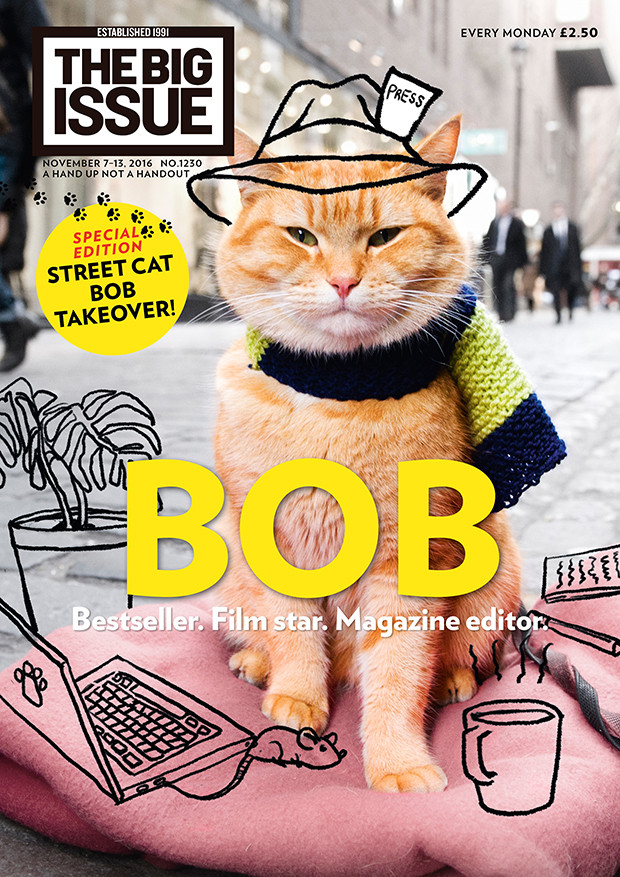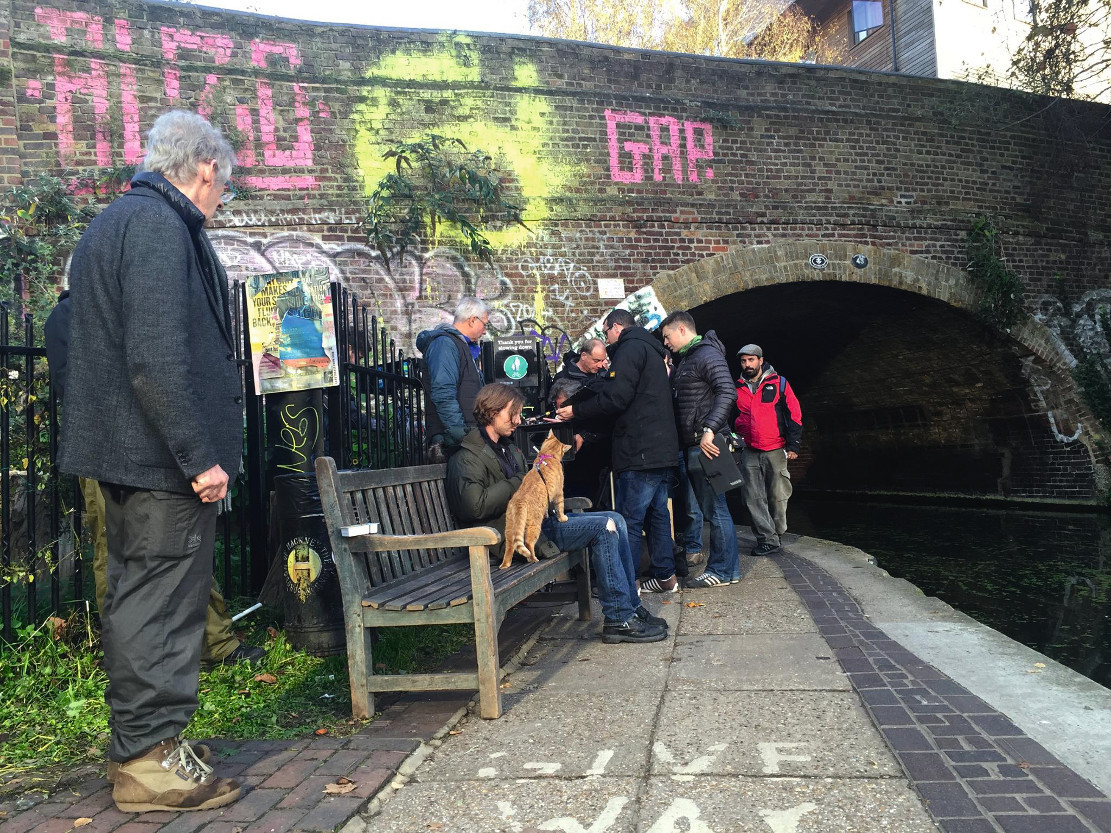The six weeks spent filming scenes for “A Street Cat Named Bob Movie” were nothing short of extraordinary. From the misty mornings on the Millennium Bridge to the bustling Covent Garden area, each day brought a new layer of excitement and delightful surprise. It was in Covent Garden, outside Bow Street Magistrates, that an unforeseen miracle involving Bob unfolded one evening.
Luke Treadaway, the actor portraying me in the film, was shooting a scene where he busks in a quiet alleyway, singing “Silent Night.” Director Roger Spottiswoode, having already met and taken a liking to Bob, decided to include him in the shot. Covent Garden was, after all, Bob’s familiar territory. He had spent countless hours there with me, patiently sitting on his blanket as I busked to earn enough for meals and bills.
However, when the cameras began to roll, Bob did something truly remarkable. As extras walked by and dropped coins into the guitar case, Bob looked up at each of them and nodded, almost as if acknowledging their contribution with a silent ‘thank you.’
Roger’s reaction was priceless. You could see the question forming in his mind, “Did I really just witness that?”
He had. And he saw it happen again, take after take.
 Luke Treadaway on set with director Roger Spottiswoode and Street Cat Bob in Covent Garden
Luke Treadaway on set with director Roger Spottiswoode and Street Cat Bob in Covent Garden
This spontaneous display of feline charm marked a turning point. From that moment on, Bob became an integral part of the “A Street Cat Named Bob movie,” appearing in as many scenes as practically possible. Consequently, Bob and I became almost permanent fixtures on set, including at Twickenham Studios, where the production team meticulously recreated our North London flat.
Bob proved to be a natural in the studio environment as well. In one scene, Luke (as me) is having dinner with Betty, his love interest played by his real-life girlfriend Ruta Gedmintas. The script required Bob to reject a piece of tofu offered by the vegan Betty. Another cat actor, Oscar, had previously devoured the tofu without hesitation, seeing it simply as food. But when it was Bob’s turn, he sniffed the tofu, let out a small growl, and pushed it away, precisely as written in the script. It was clear that Bob wasn’t just present; he was acting.
The more involved he became, the more Bob adapted to the filming routine. He became so accustomed to the process that when the recording light in the studio switched from red to green, signaling the end of filming, he would promptly follow the cables out of the door and head straight to his dressing room, ready to demand his meal.
Bob’s culinary preferences soon became legendary. Dairylea Dunkers became the treat of choice, with half the crew carrying packets to encourage or reward Bob on set. I recall a day near the Actors’ Church in Covent Garden when we were trying to coax a slightly grumpy Bob into performing his signature high five. It felt like we needed a supermarket’s worth of Dunkers to finally get him to cooperate.
During these moments, my role shifted to being Bob’s handler and, in a way, his acting coach. I had to develop a range of techniques to maintain his interest and ensure his gaze was directed where the camera needed it.
 James Bowen handling Bob the cat on the set of A Street Cat Named Bob movie
James Bowen handling Bob the cat on the set of A Street Cat Named Bob movie
My methods ranged from positioning myself behind the camera and clicking my fingers to using a laser pointer to guide his attention around the room. Ninety-nine percent of the time, Bob delivered exactly what was needed. Even on the rare occasions when he decided to improvise, director Roger Spottiswoode cleverly incorporated it into the scene.
For example, one day instead of sitting still as required, Bob began chasing the laser pen with great enthusiasm, pouncing whenever he got close to the red dot. Roger kept the cameras rolling and used this spontaneous behavior in a scene depicting Bob chasing a mouse around our flat. These unplanned moments often added an authentic and charming layer to “A Street Cat Named Bob movie.”
The other feline actors also played crucial roles, especially in scenes requiring more complex actions that Bob couldn’t perform. However, Bob and I contributed to these scenes as well, demonstrating how we used to ride together on our bicycle – the famed Bobmobile. This ensured that even when other cats were involved, Bob’s essence remained central to the film.
 James Bowen and Bob the cat riding the Bobmobile, recreated for the movie
James Bowen and Bob the cat riding the Bobmobile, recreated for the movie
Watching my life story unfold on film was already a surreal experience. But seeing it recreated in the very locations that had shaped my reality was profoundly strange. During that initial filming day near Bow Street, walking past the old Magistrates building triggered a powerful flashback. Around twenty years prior, shortly after becoming homeless, I had been arrested nearby and taken to that very courtroom, charged with begging. All I was doing was trying to exchange luncheon vouchers for cash, a transaction the other person was perfectly happy with. The police, however, decided to make an example. Despite pleading not guilty, I was taken to court, only to be found not guilty – a complete waste of everyone’s time. This memory underscored the authenticity and emotional depth that filming in these real locations brought to “A Street Cat Named Bob movie.”
After filming wrapped, during a photoshoot with Bob and me near Covent Garden tube station, another encounter with authority echoed my past. Our photographer was suddenly reprimanded by the ‘Covent Guardians,’ the council officers who regulate street performers in the piazza. It instantly transported me back to my days of busking in the area, constantly navigating the boundaries set by these officials. These real-life echoes made the filming process and the story of “A Street Cat Named Bob movie” even more poignant and personal.
It was in this familiar area that our six-week film adventure concluded. Without revealing too much, it’s in Covent Garden that the movie reaches its emotional climax. For that final scene, the entire western end of Covent Garden Piazza was filled with fire-eaters, jugglers, and a vibrant array of street performers. Adding to the festive atmosphere, a group of cheerful schoolchildren sang songs. It was a joyous and fitting end to an incredibly joyous period in my life.
They say that the end of filming a movie feels like the end of a relationship. The bonds formed are intense, forged through working closely together day after day. Then, suddenly, it’s over. I am fortunate to have maintained friendships with Adam Rolston, the movie’s producer, Luke and Ruta, and Anthony Head, who played my father. I’ve even visited the cat wranglers in Canada. I’m hopeful these friendships, born from the shared experience of creating “A Street Cat Named Bob movie,” will endure.
Two things are certain to endure. Firstly, Bob himself, now immortalized on film, forever captured in his ginger glory. And secondly, the memories of those remarkable six weeks. They will remain with me always, a testament to the magic of filmmaking and the extraordinary cat named Bob, the true star of “A Street Cat Named Bob movie.”
A Street Cat Named Bob is available to watch now.
